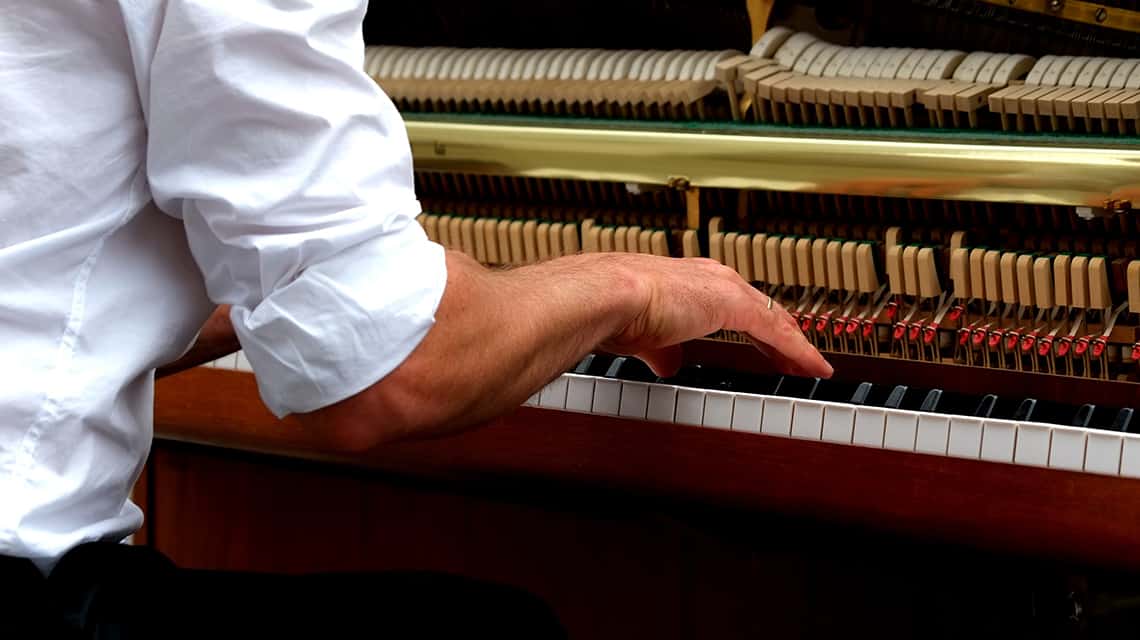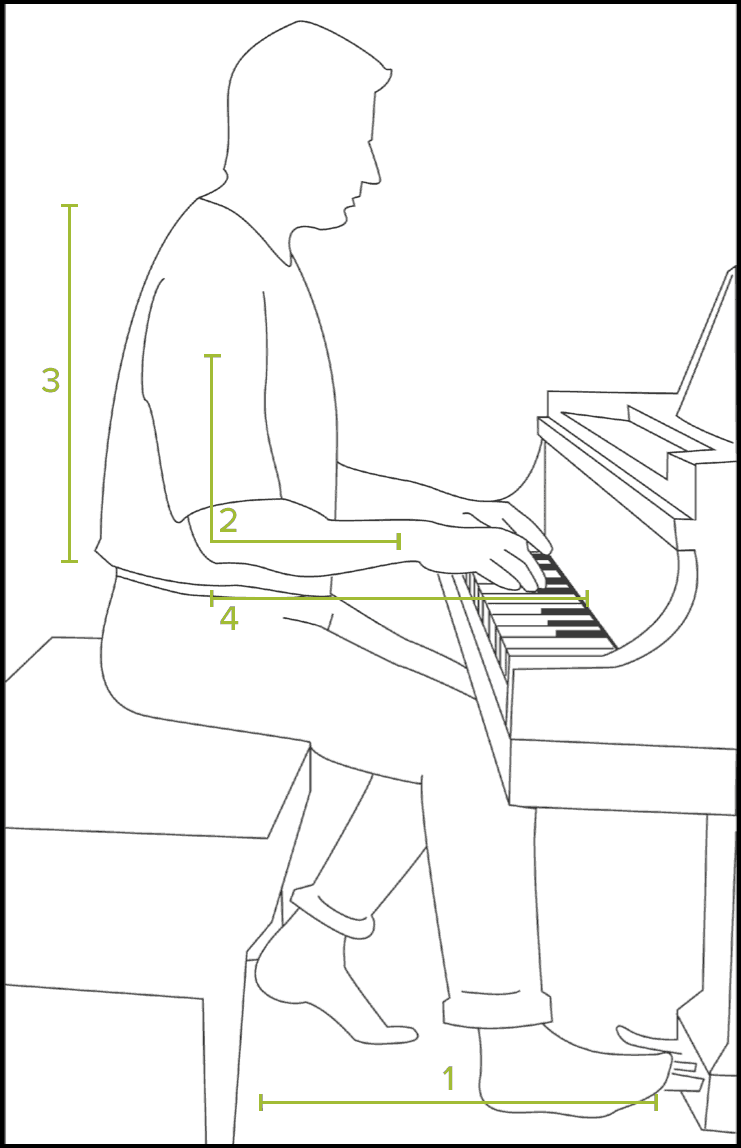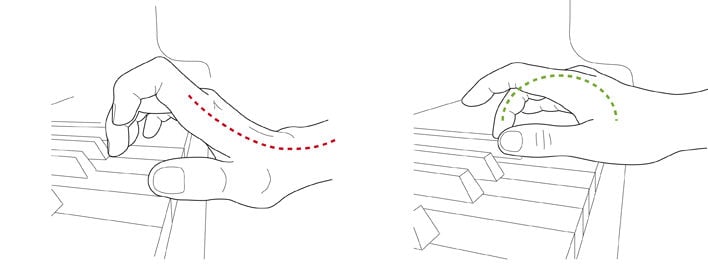Piano Posture: Stay Injury Free with These Tips
Without the right piano posture, we can strain our bodies to the point of pain. Being mindful of posture can alleviate and prevent years of discomfort.

To a non-musician, it might seem funny that someone could get hurt playing the piano. It’s a pretty low-key, low-risk activity, after all. But, for those of us who spend a lot of time at our instrument, we know the strain that it can put on our bodies.
Being mindful of your posture and form at the piano is crucial. It is far too easy to form bad habits that can lead to years of pain and discomfort.
If you are already feeling any pain or discomfort at the piano, seek advice from a professional.
Set yourself up for success and a lifetime of pain-free piano playing by following these tips to avoid injury at the piano.
1. Find the Right Piano Posture
Sitting at the piano is unlike most other places that we tend to sit, so it’s important to know these key points.

- The bench should be away from the piano. Do not scoot it in like you would a chair to a desk. Instead, leave the bench out from the piano a little way, sit on the front half of the bench and lean forward just a little towards the keys. If you fully extend your arms, they should just reach the fallboard of the piano. Your feet should sit flat on the floor and when you use the pedal, your leg will be just slightly extended.
- When you sit at the piano, your arms should form a 90-degree angle at your elbows. Your hands, wrists, and forearms should be level. Don’t let your wrists dip lower than the keys or curve higher than your hands.
- Keep a straight back with relaxed shoulders. Avoid slouching or rounding forward.
- Your arms should be able to extend to reach any key on the piano without scooting your body over on the bench. You may have to lean in, to the right or to the left, but if you can’t reach a key, readjust the bench.
2. Relax and Avoid Tension
Feeling relaxed at the piano should always be at the forefront of your mind. The minute tension enters into your playing, you’re setting yourself up for a possible injury or uncomfortable piano practice.
Before you begin playing, take a moment to take inventory of how your body feels. Do you feel tension before you even begin? If so, take a moment to release the tension.
Some common areas of tension for pianists are:
Shoulders: Many people carry a lot of tension in their shoulders and it’s really common for the shoulders to inch up toward the ears. When you first sit down at the piano, make sure that your shoulders are relaxed and lowered. If you notice them tightening and creeping upward during your practice, take time to stop and relax them.
Hands: You want your hands to look soft and rounded as you play. Each finger should move with ease. The joints in your fingers should make your fingers look curved rather than angled. Try tightening your hands into a very tight fist, then letting them slowly release. The way your hand looks in the released position is how they should fall onto the piano keys.

Back: It’s so easy for the back to feel fatigued or tense at the piano. Many of us aren’t used to supporting ourselves on a seat without a back for periods of time. If your back feels uncomfortable at the piano, don’t force yourself to stay at the piano. Take frequent breaks and adjust your posture.
It’s beneficial to incorporate relaxation exercises into your daily routine. Try some yoga or stretching videos. Alexander Technique is very helpful for pianists and musicians in general. Be aware of your posture throughout the day, not just when you are practicing.
3. Engage Your Core
This seems strange to a lot of pianists because many of us don’t give any thought to our core when we are playing the piano. But, you will notice a big difference in how you feel and how you sound if your core is engaged. An engaged core provides more support for your body. It helps your arms move with ease and gives you more control over your playing.
Take time to strengthen your core. Athletes do this as a matter of course and musicians should, too. Find some good core exercises and perform them on a regular basis throughout the week. If you are at a loss on where to begin, basic planks are a great place to start. Pilates is another great resource for building your core.
4. Keep Soft Hands
Your hands should obviously be a big focus at the piano since they are what actually comes in contact with the keys. As you play, your hands should remain soft. If someone pressed into your hands as you are playing, they should feel flexible and move a little.
When our hands don’t stay soft they become very tense and firm. They do not move easily and the tension moves up our body into the arms, shoulders, neck, and back. It can be easy to slip into this if you’re concentrating hard on a certain passage, or if you have nerves while performing.
Playing piano with tense hands produces a rigid attacking sound, but playing the piano with soft hands produces a beautiful, musical tone.
5. Allow your arms to be heavy
It may seem that if you are playing the piano with soft hands, you won’t get a very full sound at the piano, but the key to a full sound is letting the weight of your arms drop into the keys produce the sound.
To get the idea of how this works, sit at the piano and let your arms dangle freely at your sides. Notice the weight of your arms. They should feel dense and heavy. Now bring your hands to the keys. Keep the heaviness of your arms while maintaining soft hands.
As your hands approach the keys, imagine that you are going to sink your finger into molding clay using only the heaviness of your arms. Playing the piano with this technique will ensure a relaxed posture as well as a beautiful sound.
By maintaining heavy arms, you are preventing your upper arms and shoulders from carrying the weight of your arms. When you leave your shoulders out of the equation, your arms are free to move with ease.
Watch this performance of Chopin’s Nocturne in E Flat Major (Op. 9, No.2) and notice how light the pianist’s hands and fingers look as her arms do most of the work.
Many pianist and musicians have to learn these tips the hard way after suffering from pain or a long term injury as a result of overuse or poor form. If you are fortunate enough to have avoided injury at the piano, tune in and make sure that your body feels relaxed and comfortable as you play. If you notice anything that feels off, stop find a better approach.
Click here to learn more about piano posture from a Physical Therapist’s point of view.
This post was written by Megan, piano teacher and author of Pianissimo: A Very Piano Blog. Visit her website for more piano related blogs for teachers, parents, students, and all things piano.
Need some piano sheet music? Click here to check out the world’s largest digital sheet music collection at Musicnotes.com.
FAQ
- Do pianists look at their hands? That depends upon what they are playing and what type of performance they are giving. Concert pianists who have their music memorized may look at their hands a lot. They have no music, so they are free to look at their hands as much as they want. Pianists who are accompanying a choir or a soloist are probably reading music. They will not look at their hands very much as it’s better for them to keep their eyes on their music. Generally speaking, if you are playing with music, it’s a good idea to not look at your hands much. It will slow you down. If you need to look at your hands due to technical difficulties, such as big jumps in the left hand, you’re better off memorizing the piece.
- Should you look down when playing piano? If you really need to, sure. Just remember that every time you look down you have to look back up and find your place in the music again. Even though that might take a split second, it still interferes with the timing of your piece. It’s best to keep looking down to a minimum unless you have the piece memorized.
- How should you practice piano hand posture? You should never play with poor hand posture. Therefore, each day when you sit down to practice, the first thing you do is set up your hands correctly. Make sure you have a good piano hand position. When you get to the end of the piece or section you are practicing, do a hand check. Are your wrists above the keyboard? Are they level with the backs of your hands? Are your fingers curved? Make adjustments as needed before you continue on to your next piece. When your hands are fatigued, stop. It is better to quit playing than to play with poor posture.
- Are there different piano postures? It’s true that some pianists play with a very interesting piano posture. Watch a video of the legendary Glenn Gould and you’ll notice that he breaks just about all the “rules” of proper piano posture. However, he had a unique technique that worked beautifully for him. This technique demanded that he sit very low and approach the keyboard in a different way. For most pianists, the piano posture outlined above will not only enable proficient playing but a healthy, strong technique that is sustainable for years to come.

